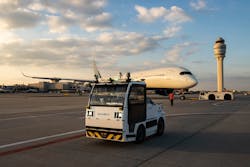How AeroVect is Preparing Autonomous GSE for Prime Time
When Eugenio Donati and Raymond Wang founded their start-up technology company in 2020, their objective was to bring autonomy to the ground support equipment market and apply it to real-world uses.
“We wanted this to be tested in live operations from the beginning, not a mock turnaround – an actual day-to-day cargo operation,” Donati says. “That’s the only way to actually stress test the system.”
AeroVect is pushing forward with that mission, having already announced partnerships with GAT Airline Ground Support and dnata, and piloting their self-driving GSE solution with Delta Air Lines.
“These guys are very motivated, very smart,” says Lourens van Aswegen, director of GSE at Delta Air Lines. “So, we had faith in starting something with them and seeing if the technology is ready for prime time.”
Throughout 2022, AeroVect has announced a series of partnerships to pilot and deploy autonomous GSE across multiple airports both in the United States and abroad. To test its technology in real-world scenarios, baggage and cargo tractors have been equipped with the self-driving AeroVect Driver to carry out live tasks in the busy airport environment.
“AeroVect’s autonomous GSE technology is not only useful and practical, but importantly a big step forward that enhances ramp safety,” said GAT CEO Mike Hough, when AeroVect announced its first of three partnerships earlier this year. “GAT Airline Ground Support has always been a first mover in the ground support industry, and we continue to invest in new frontier technologies that enable us to offer the safest, most efficient, and most reliable ground support service to our airline partners across major airports in the United States.”
In a recent pilot of its technology, a vehicle powered by the AeroVect Driver system was required to navigate six aircraft crossings, 12 intersections, one underground tunnel and two checkpoint gates – requiring the technology to negotiate many decision-making areas.
“The biggest question marks for folks when it comes to autonomous driving is the interaction with the airplanes,” van Aswegen says. “It’s a very data-heavy approach that takes in a lot of pieces of information to try and enhance that decision making. But when it gets to waiting for an airplane to cross a taxiway or determining the right time to cross the taxiway after the aircraft is no longer blocking the path to avoid the jet blast, those are things that are tough even for people to figure out.”
From a technical standpoint, an evaluation of the technology can determine if the judgement of the system is equivalent or better to a human’s judgement in critical situations, such as giving way to airplanes at aircraft crossings. Then from a practical standpoint, a pilot aims to determine if the autonomy is as safe or better than a human driver and as efficient or more efficient as a person carrying out the task.
The AeroVect Driver’s array of lidar sensors and cameras work in tandem with GPS technology to operate the tractor. The technology allows the vehicle to stay within driving lanes as well as identify and classify objects such as aircraft, other vehicles and people to determine the correct behavior.
A formal evaluation of AeroVect’s technology that took place in October was designed to determine if the technology performs as intended and whether the technology can work in concert with the other key stakeholders located at the airport.
To support this pilot effort, AeroVect stationed a significant portion of its team onsite to oversee the operation.
“We truly care about the success of our customers,” Wang says. “We specifically serve airport customers and we’re always committed to that.”
According to Wang, AeroVect’s commitment to an autonomous pilot includes ensuring the company delivers on everything promised from the pre-pilot assessment to the pilot itself as well as establishing clear plans for scaling to hundreds of units – not just as a theoretical concept.
He says it is important to demonstrate AeroVect is thinking through every step and working with the appropriate stakeholders to make sure the technology works as it’s intended to.
The amount of cargo transported autonomously during an evaluation period varies from day to day.
“It’s whatever the operation demands,” Donati says.
The scope of the recent evaluation expanded beyond how many times a day the tractor could complete its task. For example, the technology’s effectiveness during different times of day and across various shifts was also examined.
“You want to validate that the system works no matter if it’s day or night, no matter if it’s rain or shine,” Wang says, noting AeroVect had a weekly target to hit, but could transport more cargo when needed.
According to Donati and Wang, interest in autonomous GSE has grown in recent years. The concept of autonomy was being explored before AeroVect was established in 2020. But as airlines and other industry stakeholders recovered from the pandemic, efforts to test and deploy the technology has gained momentum.
While exhibiting at the International GSE Expo in Las Vegas in 2021, Wang says members of the GSE industry met with AeroVect and began validating the company’s technology.
“They literally saw it with their own eyes, running around the demo lot,” Wang recalls.
“As a company, we’ve progressed significantly since then,” he adds, noting the demo unit at the International GSE Expo was an older tractor and the AeroVect Driver has since been installed on newer tractor models.
“We’re not just doing this as a cool robotics project. We’re not doing this by importing over adjacent technologies into a new space. We’re doing it by building it specifically for this space,” Wang says.
According to Donati and Wang, AeroVect’s recent pilot was the next step in validating their ability to bring autonomous GSE to airports by demonstrating the technology in an extremely busy environment with several navigational challenges.
Donati says the level of confidence AeroVect’s partners have shown has made a key difference.
“In terms of bringing autonomy to market at true scale, you have to work with the largest airlines at the largest airports,” he says.
Optimizing Equipment
The AeroVect Driver system uses components available on the market. These sensors, cameras and devices can be installed on any vehicle, providing flexibility to customers.
“Fundamentally, for us, we’re platform agnostic,” Wang says. “So, it doesn’t really matter the underlying vehicle. It’s the same to us. It has a wheel, it has an accelerator and brake, it drives the same way fundamentally across the board.”
When AeroVect announced its partnership with dnata in September of 2022, the technology’s flexibility was important to the ground handler.
“We partnered with AeroVect for certain reasons. One of them being that AeroVect is an OEM-agnostic company,” Bartu Korgul, head of GSE planning at dnata, said. “We operate a diverse fleet globally. We consistently review our processes and invest in the latest technologies to deliver the highest level of service and safety. We want to work with suppliers that best meet our demands. We want to stay agnostic.”
What’s Next
Throughout the recent pilot and evaluation period AeroVect’s team generated large quantities of data by logging many, many hours on the unit.
As autonomous GSE pilots are conducted and new opportunities arise, AeroVect is quickly growing as a company.
But Wang notes more important than increased head count is the quality of people being brought on board to support the company’s mission.
“The way we built this company was by bringing together people who are really, really passionate about aviation and folks who are really passionate about autonomy. That’s what, at the end of the day, has made this work,” Wang says.
“Engineering is the No. 1 focus for us. I think as we transition from doing our initial pilots with customers and actually scaling the first 10, 20, 30 units, then we’ll also start growing our operations teams,” Donati adds.
AeroVect has two key objectives moving forward as a company.
The first is to continue its commitment to deploying the technology and growing the maturity of the technology, Wang explains.
“We want to make sure that this is autonomy that can work – safety driver out – 24/7 making these runs,” he says. “That’s a big piece in which we’re growing the product.”
The other key focus is meeting the demand for the technology and expanding beyond single deployments and scaling up to multiple units at a location.
As AeroVect’s company grows, its software’s abilities are growing too. Constant improvements are made to the autonomy software to allow it to handle more complicated scenarios and environments.
“Every single new scenario it sees, it ingests that, incorporates how to handle that and next time we see a similar scenario, it knows how to handle that very, very well,” Wang says.
“Probably the biggest things that have happened from our work here, so far, is that it’s been exposed to the complexities of the world’s busiest airport and many scenario-based complexities,” he adds. “Today, we’re handling those cases.”
About the Author
Josh Smith
Editor
Josh Smith served as editor of Ground Support Worldwide as editor from 2016 through 2024. He oversaw production of the print magazine, created GSW's newsletters on a daily basis, and updated the latest news on AviationPros.com.

